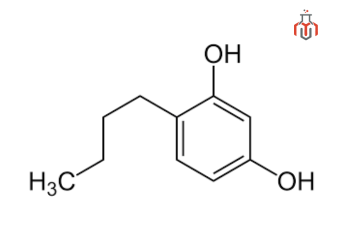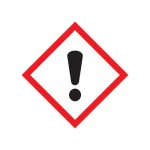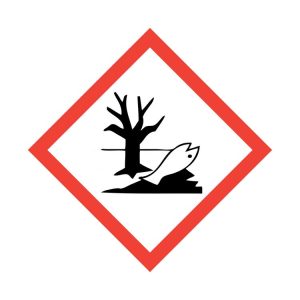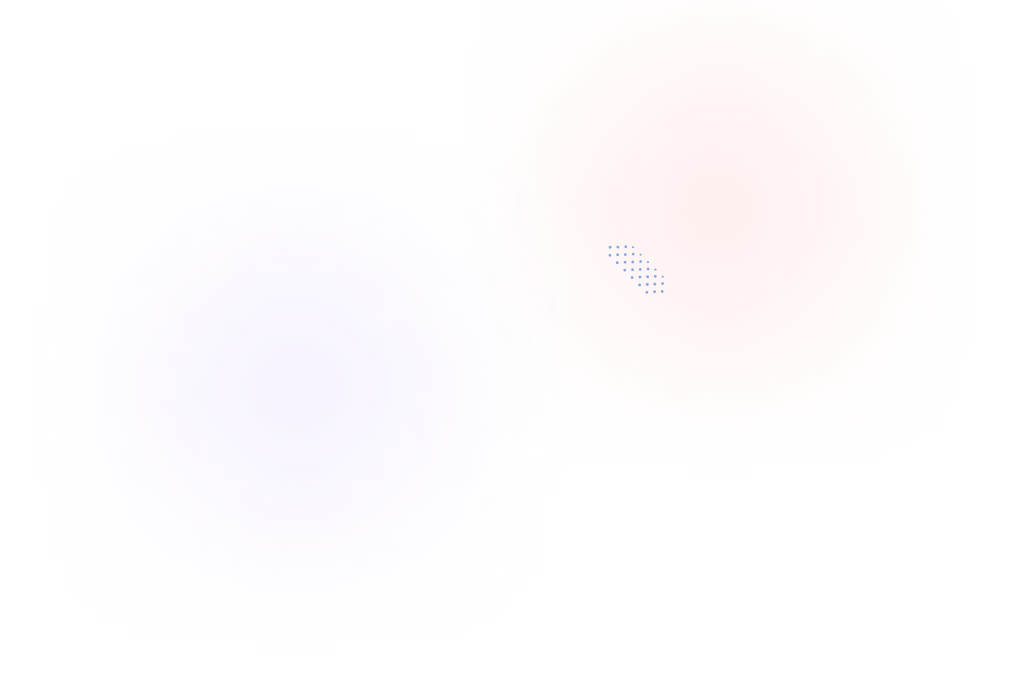What is 4-Butylresorcinol?
4-Butylresorcinol, also known as 4-n-butylresorcinol, is a derivative of resorcinol, and it inhibits human tyrosinase, an enzyme responsible for melanin production. It helps to improve skin tone, lighten hyperpigmentation, and decrease skin irritation by reducing melanin synthesis. It is widely used in skincare products to treat various skin conditions, including melasma, post-inflammatory hyperpigmentation, acne scars, solar lentigines, and signs of aging. It also helps to improve skin hydration, density, and overall complexion.

CAS No.: 18979-61-8
Synonyms: Butylresorcinol; Rucinol; Resorcinol, 4-butyl-; 4-n-Butylresorcinol; Kopcinol
Properties of 4-Butylresorcinol
| Physical Properties | |
| Chemical formula | C10H14O2 |
| IUPAC Name | 4-butylbenzene-1,3-diol |
| Molecular weight | 166.22 g/mol |
| Solubility | Soluble in organic solvents; Poorly soluble in water |
| Flash point | 145°C |
| Density | 1.092 ± 0.06 g/cm3 |
| Chemical Properties | |
| Color | White to Beige or Pink |
| State | Solid Powder or Crystals |
| Melting point | 53°C |
| Vapor Pressure | 0.041Pa at 25℃ |
| pKa | 9.95 ± 0.18 |
| LogP | 2.8 at 24℃ and pH7 |
Uses of 4-Butylresorcinol
4-Butylresorcinol for skin
- It acts as a tyrosinase inhibitor, helping to regulate melanin production for an even skin tone.
- 4-Butylresorcinol is primarily utilized in skincare products for its skin-brightening and hyperpigmentation-reducing properties. It is used in skin-brightening creams and serums to reduce hyperpigmentation, dark spots, and melasma.
- It protects the skin from oxidative damage caused by free radicals.
- It can help reduce inflammation in the skin.
- 4-Butylresorcinol can be used to treat the skin disorders like Acne vulgaris and atrophic scarring.
Anti-Aging Formulations
- 4-butylresorcinol has antioxidant properties that protect the skin from environmental damage. This makes it a valuable ingredient in anti-aging products, helping to reduce fine lines, wrinkles, and age-related pigmentation.
Side effects of 4-Butylresorcinol
- Mild Erythema (Redness): Sometimes, its use may cause temporary skin redness.
- Skin Irritation: It can cause mild irritation or a slight burning sensation after applying.
- Dryness & Peeling: There are also chances of flaking and dryness of skin in some individuals.
- Increased Sun Sensitivity: It induces skin’s sensitivity to the sunlight.
| Pictograms : |   |
| Hazard Statements : | H302: Harmful if swallowed. |
| Precautionary statements : | P264: Wash skin thoroughly after handling. P270: Do not eat, drink or smoke when using this product. P273: Avoid release to the environment. P301 + P312: IF SWALLOWED: Call a POISON CENTER/ doctor if you feel unwell. P302 + P352: IF ON SKIN: Wash with plenty of water. P305 + P351 + P338: IF IN EYES: Rinse cautiously with water for several minutes. Remove contact lenses, if present and easy to do. Continue rinsing. |
What is 4-Butylresorcinol?
4-Butylresorcinol, also known as 4-n-butylresorcinol, is a derivative of resorcinol, and it inhibits human tyrosinase, an enzyme responsible for melanin production. It helps to improve skin tone, lighten hyperpigmentation, and decrease skin irritation by reducing melanin synthesis. It is widely used in skincare products to treat various skin conditions, including melasma, post-inflammatory hyperpigmentation, acne scars, solar lentigines, and signs of aging. It also helps to improve skin hydration, density, and overall complexion.

CAS No.: 18979-61-8
Synonyms: Butylresorcinol; Rucinol; Resorcinol, 4-butyl-; 4-n-Butylresorcinol; Kopcinol
Properties of 4-Butylresorcinol
| Physical Properties | |
| Chemical formula | C10H14O2 |
| IUPAC Name | 4-butylbenzene-1,3-diol |
| Molecular weight | 166.22 g/mol |
| Solubility | Soluble in organic solvents; Poorly soluble in water |
| Flash point | 145°C |
| Density | 1.092 ± 0.06 g/cm3 |
| Chemical Properties | |
| Color | White to Beige or Pink |
| State | Solid Powder or Crystals |
| Melting point | 53°C |
| Vapor Pressure | 0.041Pa at 25℃ |
| pKa | 9.95 ± 0.18 |
| LogP | 2.8 at 24℃ and pH7 |
Uses of 4-Butylresorcinol
4-Butylresorcinol for skin
- It acts as a tyrosinase inhibitor, helping to regulate melanin production for an even skin tone.
- 4-Butylresorcinol is primarily utilized in skincare products for its skin-brightening and hyperpigmentation-reducing properties. It is used in skin-brightening creams and serums to reduce hyperpigmentation, dark spots, and melasma.
- It protects the skin from oxidative damage caused by free radicals.
- It can help reduce inflammation in the skin.
- 4-Butylresorcinol can be used to treat the skin disorders like Acne vulgaris and atrophic scarring.
Anti-Aging Formulations
- 4-butylresorcinol has antioxidant properties that protect the skin from environmental damage. This makes it a valuable ingredient in anti-aging products, helping to reduce fine lines, wrinkles, and age-related pigmentation.
Side effects of 4-Butylresorcinol
- Mild Erythema (Redness): Sometimes, its use may cause temporary skin redness.
- Skin Irritation: It can cause mild irritation or a slight burning sensation after applying.
- Dryness & Peeling: There are also chances of flaking and dryness of skin in some individuals.
- Increased Sun Sensitivity: It induces skin’s sensitivity to the sunlight.
| Pictograms : |   |
| Hazard Statements : | H302: Harmful if swallowed. |
| Precautionary statements : | P264: Wash skin thoroughly after handling. P270: Do not eat, drink or smoke when using this product. P273: Avoid release to the environment. P301 + P312: IF SWALLOWED: Call a POISON CENTER/ doctor if you feel unwell. P302 + P352: IF ON SKIN: Wash with plenty of water. P305 + P351 + P338: IF IN EYES: Rinse cautiously with water for several minutes. Remove contact lenses, if present and easy to do. Continue rinsing. |
FAQ's
4-Butylresorcinol is safe for topical application. It is usually well accepted by various skin types and is frequently used for the treatment of melasma.
It is typically used in creams, serums, and lotions at a concentration of 0.1% to 1%. For optimal results and stability, it should be combined with other skin-friendly ingredients.
4-Butylresorcinol directly blocks the tyrosinase enzyme, which is crucial for melanin production, while tranexamic acid works by inhibiting the plasminogen activator, which indirectly reduces melanin synthesis.
It is used for the treatment of hyper pigmentation, melasma, dark spots, and uneven skin tone. It works by inhibiting melanin production, resulting in a brighter complexion.
4-Butylresorcinol is considered a safer and more stable alternative to hydroquinone. It helps reduce hyperpigmentation with fewer side effects, making it a preferred ingredient in skincare products.
4-Butylresorcinol is also referred to as Rucinol.
It’s advisable to consult a doctor before using 4-butylresorcinol in pregnancy.
4-Butylresorcinol works by inhibiting tyrosinase, an enzyme responsible for melanin production, and by reducing melanin production. It helps lighten the dark spots, melasma, and other types of hyperpigmentation.


